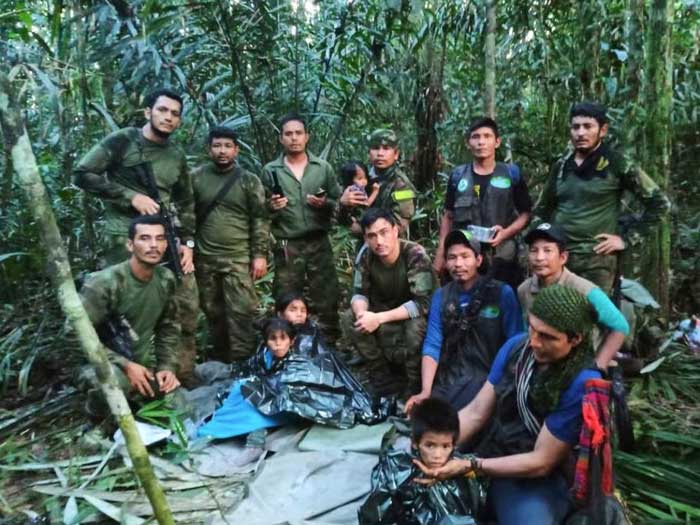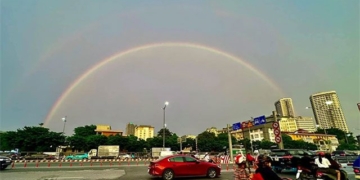Four children survive 40 days in the Amazon rainforest in Colombia after their plane crash last month. The accident resulted in the deaths of all three adults on board, including the children’s mother.
The four children, aged 13, 9, 4, and 1, were rescued on June 9 after rescue teams spent weeks searching remote areas of the jungle, home to jaguars, ocelots, and venomous snakes.
The people of Colombia expressed immense joy at the survival of the four children in the wilderness.
How Did the Children Survive for So Long?
According to the Washington Post, it is still unclear exactly how the children managed to survive, but The Indigenous Organization of Colombia in the Amazon tweeted that their survival is a “sign of the knowledge and relationship with the natural environment that the children have been taught and learned since before birth, practiced from a very young age.”
This sentiment was echoed by Fátima Valencia, the children’s grandmother. Speaking to AFP, she noted that the oldest sibling, 13 years old, has a nature akin to a “warrior” and “always cares” for her younger siblings, including by sharing fruits from the jungle. Meanwhile, the children’s grandfather mentioned that the two brothers aged 9 and 4 walked through the jungle with remarkable skill.
Carlos Peres, a tropical forest ecology professor at the University of East Anglia in the UK, who has worked with eight Indigenous groups in the Amazon, stated in a phone interview on June 10 that the children’s knowledge of the forest helped them survive.
He remarked: “Four Western children of the same age would not survive in similar conditions, but many children from Indigenous communities in the Amazon “grow up very early” and learn basic survival skills in the jungle from a young age, including how to find food and avoid predators. In some communities where he has lived, children can start climbing trees as early as one year old.”

The children found after 40 days surviving in the jungle. (Photo: AFP).
Peres indicated that obtaining water would not be an issue, as there are streams and creeks in the area, and Indigenous children can quickly build temporary shelters, like the one rescuers found last month during their search for the children.
He stated that this experience will be very traumatic for the children, “but they are also fighting to survive. And they will know how to accept those conditions.”
For outsiders, “the interior regions of the Amazon rainforest may seem much scarier than they actually are, especially if you are born there,” Peres continued.
“In this area of the Amazon, there are about 80 different species of snakes, but only five of them are venomous, and they [the Indigenous people] can distinguish between venomous and non-venomous snakes.”
“The only thing I regret more than anything is that all the knowledge that saved these children is rapidly disappearing throughout the Amazon,” he added.
Public Reaction
Colombian officials described the rescue of the children as a miracle. “A joy for the whole country!” tweeted Colombia’s president on the evening of June 10. “They were all alone,” he told local media. “They have become an example of survival. This story will go down in history, so today those children are the children of peace and the children of Colombia.”
The country’s child protection agency tweeted that “being reunited with them, safe and with their family, is an indescribable joy.”
“The four minors who survived the plane crash in Guaviare are a light of life and hope illuminating Colombia,” said the U.S. Embassy in Bogotá, thanking the Colombian armed forces “for the heroic search and rescue mission in such difficult terrain and for giving us this great joy.”
President Petro told local media that he hopes to speak with the children and officials who are waiting for doctors to assess their health.
“After 40 days, their health must have deteriorated,” he said, adding that protecting the mental health of the four children is also very important.
When Did the Plane Crash and How Were the Children Rescued?
According to authorities, the plane was flying from the southern town of Araracuara when it disappeared on May 1. The search team later discovered aircraft wreckage and the bodies of the pilot, the children’s mother, and another adult—yet the children, belonging to the Huitoto Indigenous people, were no longer at the crash site. A report indicated that the children were seated in the back of the plane, which was less damaged in the accident.
Shortly after, rescue teams found clues that raised hopes that the children were alive. First, they found a pair of children’s shoes near the crash site. Then, they found a diaper, an uneaten fruit, and a bottle in the jungle.
According to the aviation authority, the rescue teams later discovered a temporary shelter made from sticks and branches, as well as scissors and some hair ties. They also found small footprints about 3 kilometers from the crash site.
More than 100 military officers, as well as volunteers from Indigenous communities, participated in the search activities. The children’s grandmother recorded a message in their native language, Huitoto, instructing them to stay in one place.
On June 9, Petro announced that the children had finally been found by Indigenous communities participating in the search and the military. The country’s air force stated that the four children were found just over 3 kilometers from the crash site.
The Colombian Civil Aviation Authority shared a video showing the children receiving medical care on a plane as they were transferred from San José del Guaviare to the capital Bogotá.



















































